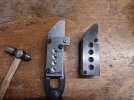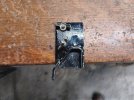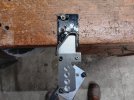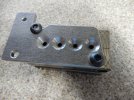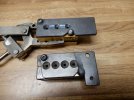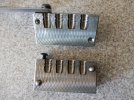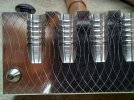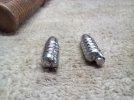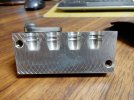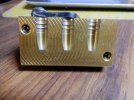Snakeoil
Well-Known Member
My new 4-cavity 32-175T mold from Accurate arrived yesterday. To my disappointment, they forgot to include the nose punch I had ordered. I was also surprised to find that the config for the sprue plate is different on the mold than what I expected. Although the ordering page only shows one kind of sprue plate with the choices being standard or trough, it appears that 4-cavity and larger get a sprue plate with a different end by which the sprues are cut. Here is what I mean.
This is what I was expecting. This is what I received.
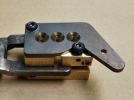
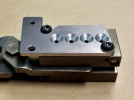
The first one better lends itself to a bench mounted bracket for opening, which is what I prefer. I find that 4-cavity and larger cannot be opened with a gloved hand, well not my arthritic gloved hand.
I sent an email to Tom last night that was probably too late for him to see. He's been very responsive in the past. I told him about the missing top punch, but also questioned the sprue plate shape. I truly do not understand the basis for that shape. My guess is it is designed to provide a flat surface for striking with a mallet. I'm curious what the holes in the sprue plate are for. I suppose they could be used to mount a handle to facilitate ease of opening. But a handle mounted to the sprue plate could be awkward during casting. They might be locating holes for set-up in the machining operation. I will use them to mount an adapter plate that will emulate the end of my NOE molds so that I can use the same sprue cutter bench bracket to cut the sprues. Making that plate is job one today and then I'll cast up a few bullets. Going to put the mold on the hot plate while I make the adapter and run it thru a few heat cycles to settle in the pins.
I noticed that Tom uses a wavy spring washer to position the sprue plate flat on the mold. First time I've seen this done. I imagine it will help prevent the common galling of the top of the mold over time. My concern however is it could allow the plate to flop around during the bullet drop process. With my adapter bolted to it, it might make it droop a bit and strike the face of the opposite mold half if it swings closed when the mold is open. Will have to watch for that when I start to use it and modify my technique if necessary.
Will hopefully hear from Tom later today. I was surprised to have the 6 week delivery time reduced to 4 weeks. Have been chomping at the bit waiting to try this new bullet.
This is what I was expecting. This is what I received.


The first one better lends itself to a bench mounted bracket for opening, which is what I prefer. I find that 4-cavity and larger cannot be opened with a gloved hand, well not my arthritic gloved hand.
I sent an email to Tom last night that was probably too late for him to see. He's been very responsive in the past. I told him about the missing top punch, but also questioned the sprue plate shape. I truly do not understand the basis for that shape. My guess is it is designed to provide a flat surface for striking with a mallet. I'm curious what the holes in the sprue plate are for. I suppose they could be used to mount a handle to facilitate ease of opening. But a handle mounted to the sprue plate could be awkward during casting. They might be locating holes for set-up in the machining operation. I will use them to mount an adapter plate that will emulate the end of my NOE molds so that I can use the same sprue cutter bench bracket to cut the sprues. Making that plate is job one today and then I'll cast up a few bullets. Going to put the mold on the hot plate while I make the adapter and run it thru a few heat cycles to settle in the pins.
I noticed that Tom uses a wavy spring washer to position the sprue plate flat on the mold. First time I've seen this done. I imagine it will help prevent the common galling of the top of the mold over time. My concern however is it could allow the plate to flop around during the bullet drop process. With my adapter bolted to it, it might make it droop a bit and strike the face of the opposite mold half if it swings closed when the mold is open. Will have to watch for that when I start to use it and modify my technique if necessary.
Will hopefully hear from Tom later today. I was surprised to have the 6 week delivery time reduced to 4 weeks. Have been chomping at the bit waiting to try this new bullet.

